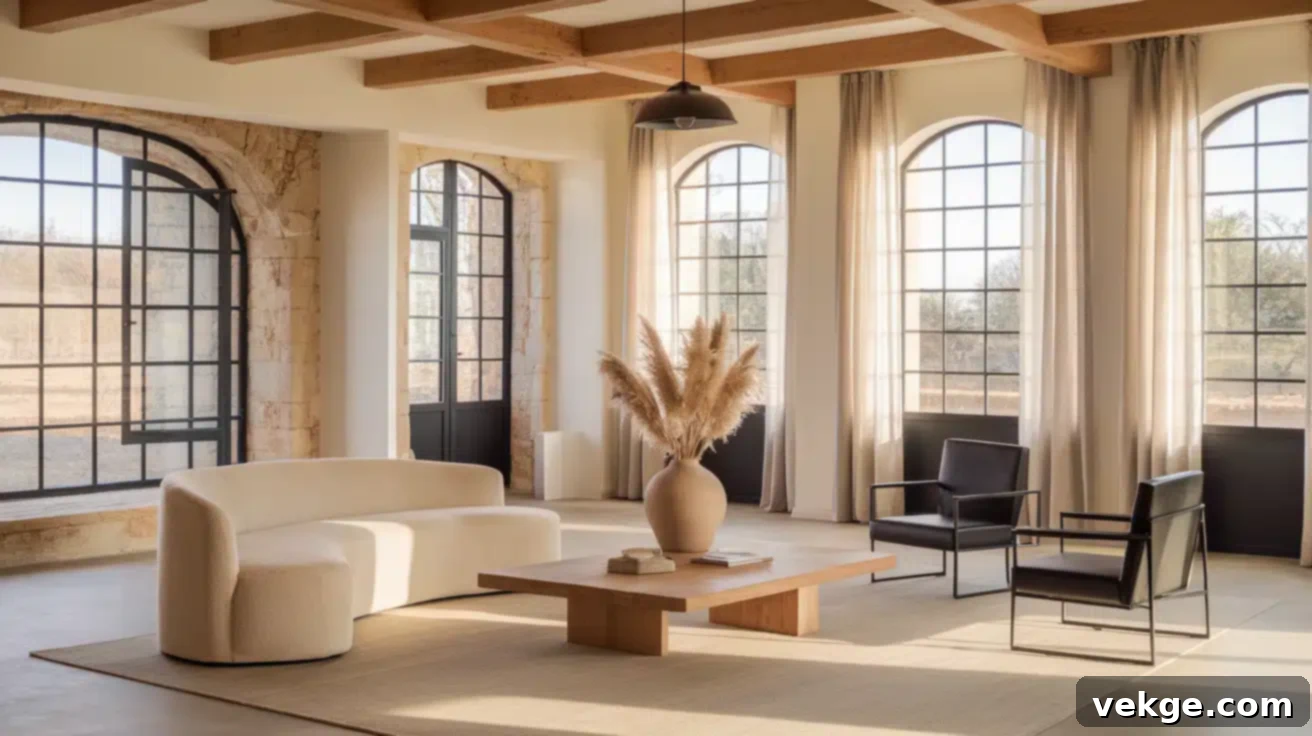Beyond Barn Doors: Unveiling the Top Interior Design Trends for a Modern Home in 2025
For nearly a decade, American homes embraced a comfortable aesthetic defined by white walls and rustic touches, making country-inspired style a beloved staple. This pervasive design movement influenced everything from compact urban apartments to sprawling custom homes, establishing a standard for cozy and welcoming living spaces. However, as we step into 2025, homeowners are increasingly seeking innovative and personalized ways to refresh and redefine their environments. This comprehensive guide delves into the most prominent interior design styles taking center stage in contemporary homes, offering practical advice and inspiration to help you update your space while preserving the comfort and warmth you cherish.
Is Farmhouse Style Fading Away in 2025?
The beloved farmhouse style, which reigned supreme in home décor for well over ten years, is indeed undergoing a significant transformation this year. While its core tenets of comfort, warmth, and a connection to simpler times remain highly valued, many of the signature farmhouse features have become ubiquitous, leading to a sense of visual fatigue across homes throughout America. The style’s widespread adoption, from budget-friendly big-box stores to high-end luxury retailers, has inadvertently rendered certain elements feeling overused, mass-produced, and, frankly, a bit dated.
This isn’t to say that everything associated with farmhouse style should be immediately discarded. The shift is more about discernment and evolution. The desire for a lived-in, authentic feel persists, but the execution is becoming more refined and less overtly thematic. Homeowners are moving away from generic, store-bought “farmhouse” kits and embracing a more sophisticated, personalized approach to rustic charm.
The Evolution of Farmhouse Style: What to Keep, What to Rethink
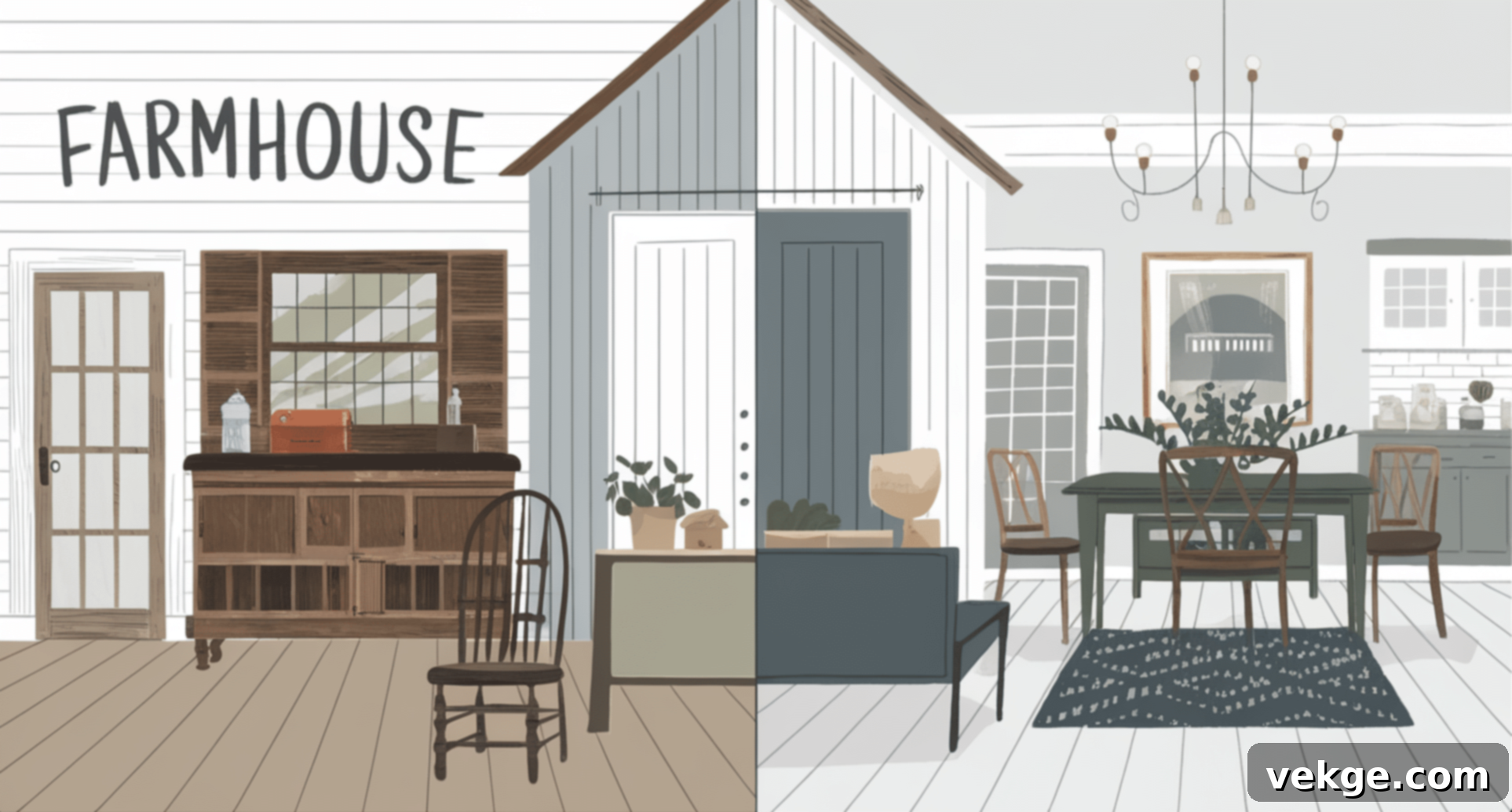
Not every element of the farmhouse aesthetic needs to be retired. In fact, many quality pieces and authentic architectural details continue to hold their charm and relevance. For instance, genuine farmhouse sinks, crafted from durable materials like fireclay or copper, remain timeless and highly functional additions to a kitchen. Similarly, solid wood dining tables, especially those with visible grain and sturdy construction, offer enduring beauty and a sense of heritage that transcends fleeting trends.
Traditional architectural elements that genuinely align with a home’s inherent character, such as original exposed wooden beams or authentic shiplap walls that reveal the building’s history, continue to be highly relevant when used thoughtfully and sparingly. These elements provide textural interest and a connection to craftsmanship that elevates a space. However, the widespread availability and overuse of mass-produced items are what primarily mark a space as outdated. This includes items like generic typography signs with common phrases, faux-distressed furniture that lacks genuine patina, and excessive buffalo check patterns, which have become synonymous with the “old” farmhouse look.
The key is to differentiate between genuine rustic charm and manufactured trendiness. Focus on pieces that tell a story, are made from high-quality materials, and reflect a sense of enduring craftsmanship rather than disposable fashion.
Emerging Interior Design Trends Replacing Farmhouse in 2025

As the design landscape evolves, several exciting and distinct styles are stepping forward to offer homeowners fresh, sophisticated, and personalized alternatives to the traditional farmhouse look. These trends prioritize authenticity, comfort, and a connection to either nature, history, or individual expression, ensuring that your home feels both current and uniquely yours.
1. Organic Modern: A Seamless Blend of Nature and Contemporary Design
This style represents a refined and fresh interpretation of natural living spaces. Organic Modern masterfully combines clean, minimalist lines with raw, tactile materials, creating environments that feel both inherently sophisticated and deeply connected to the natural world. The aesthetic emphasizes soft, curved forms, natural stone, and unfinished or lightly treated wood, all while maintaining a distinctly contemporary appeal. Spaces designed in this style often feature abundant natural light, large windows that blur the lines between indoors and out, and the deliberate incorporation of living plants as key sculptural and textural design elements. Think natural fiber rugs, sculptural wooden furniture, and lush indoor greenery set against a backdrop of muted, earthy tones.
2. Brutalism: Reimagined for Residential Warmth
Perhaps one of the most surprising yet compelling comebacks, brutalism has unexpectedly returned to residential design, but with a softer, more inviting approach. Modern interpretations of this style move beyond its stark institutional origins, focusing instead on the honest beauty of raw materials and architectural transparency. Today’s brutalist interiors expertly combine exposed concrete and steel with more comforting elements like richly textured fabrics, warm wooden accents, and strategic lighting. The result is a series of bold, architecturally significant, and surprisingly welcoming spaces that challenge conventional notions of comfort and elegance. It’s about celebrating the inherent beauty of unrefined materials, bringing a sense of grounded strength to your home.
3. Mid-Century Modern Revival: Timeless Elegance Returns
The enduring resurgence of mid-century modern design offers a sophisticated and historically rich alternative to the farmhouse style. This trend celebrates clean lines, organic curves, and a profound appreciation for functional beauty. Modern interpretations skillfully blend authentic vintage pieces—perhaps a credenza or a set of dining chairs—with contemporary items, creating spaces that feel both nostalgic and incredibly fresh. This style is instantly recognizable by its use of rich, warm woods like walnut and teak, striking bold geometric patterns, and carefully chosen color accents that add pops of personality without overwhelming the space. It’s a design philosophy that values craftsmanship, simplicity, and enduring style.
4. Rustic Luxe: Elevated Comfort with a Touch of Opulence
For those who appreciate the essence of rustic charm but desire a more refined and opulent approach, Rustic Luxe offers the perfect evolution. This style masterfully pairs natural, earthy materials with polished, sophisticated finishes and luxurious textures. Spaces embracing Rustic Luxe might feature high-quality, gleaming materials like polished marble, rich brass, or delicate silk alongside the rugged beauty of rustic wood, natural stone, or chunky knit fabrics. The result is an interior that feels simultaneously sophisticated and supremely comfortable, making it an ideal choice for homeowners looking to gracefully transition from a traditional farmhouse style without entirely abandoning its inherent warmth.
5. Japandi Style: Harmonizing Simplicity and Functionality
Japandi design represents a serene and thoughtful merger of Japanese minimalism with Scandinavian functionality. This style places a strong emphasis on clean lines, natural materials, and a profound appreciation for thoughtful simplicity. Japandi spaces are characterized by serene neutral color palettes, minimal yet impactful décor, and a celebration of functional beauty in everyday objects. The focus on meticulous craftsmanship, high-quality materials, and enduring design makes this style particularly appealing to those seeking longevity, tranquility, and a clutter-free existence in their design choices. It’s about creating an atmosphere of calm and balance.
6. Maximalism: Embracing Personal Expression and Boldness
In stark contrast to the often understated simplicity of farmhouse aesthetics, maximalism boldly celebrates personal expression, vibrant storytelling, and unapologetically bold choices. This style actively encourages the creative mixing of diverse patterns, rich colors, and varied textures. Maximalist spaces are often characterized by curated collections of cherished objects, dramatic statement artwork, and luxuriant color combinations that reflect the homeowner’s unique personality. The true art of maximalism lies in creating meaningful and harmonious arrangements, telling a rich visual story, rather than simply filling every available space without purpose.
Key Elements and Features of the New Design Trends
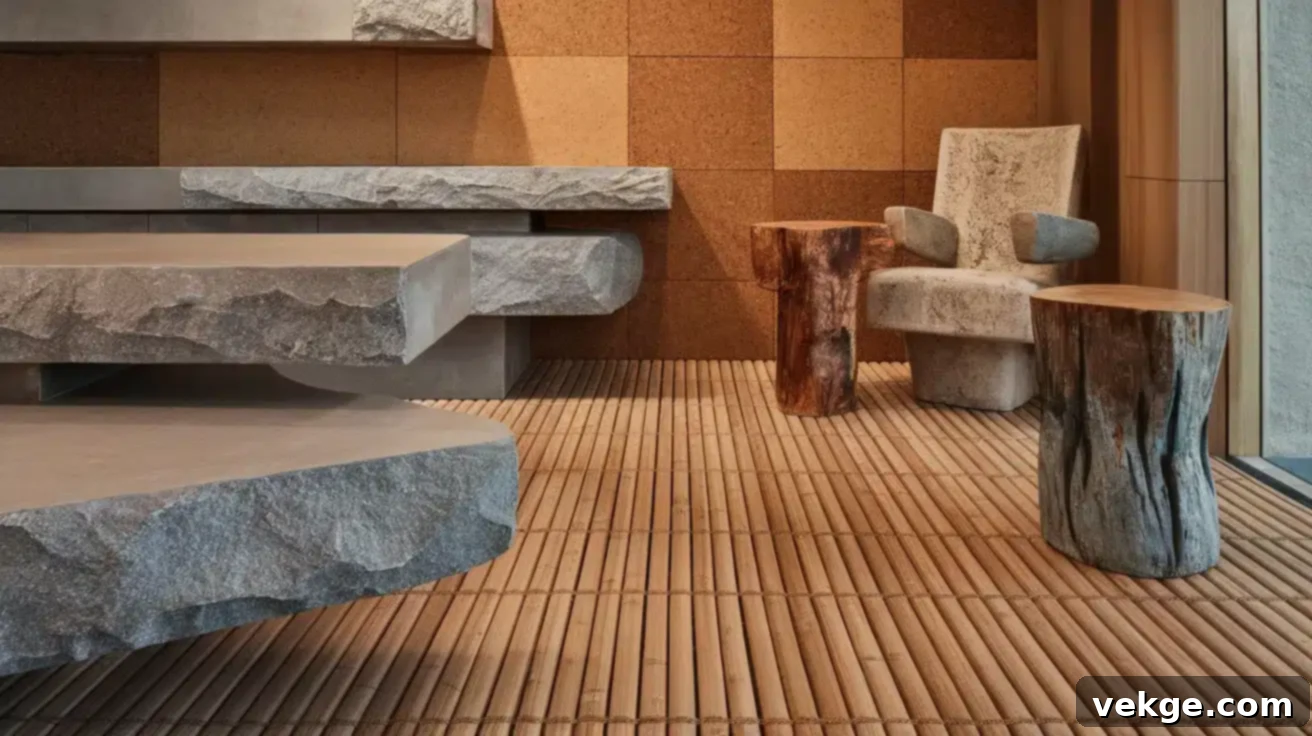
As interior design moves forward, a common thread weaves through many of these emerging trends: a profound appreciation for natural elements, thoughtful color application, and innovative architectural details. These features contribute to creating spaces that feel authentic, comforting, and visually inspiring.
Natural and Organic Materials: The Core of Modern Living
The global shift toward sustainable and mindful design has firmly placed natural materials at the forefront of contemporary home décor. Materials such as bamboo, cork, responsibly sourced wood, rattan, and linen have become central elements in modern interiors. These materials not only bring inherent warmth, organic texture, and a sense of grounding to a space but also actively support environmental consciousness and ethical production. Beyond traditional choices, manufacturers are now offering incredibly innovative options, including mushroom-based materials (mycelium), recycled composites, and reclaimed wood. These sustainable alternatives provide the tactile beauty and aesthetic appeal of traditional materials while significantly reducing environmental impact. The focus has truly moved beyond mere visual appeal to consider the entire lifecycle of each material used in home design, advocating for durability, biodegradability, and ethical sourcing.
Color Palettes for 2025: A Departure from Monotony
The new color trends for 2025 mark a refreshing departure from the pervasive all-white or stark gray farmhouse palette. Instead, rich, grounding earth tones—think terracotta, ochre, and warm beiges—and deep, calming forest greens create serene, natural environments that feel both expansive and intimate. Soft, powdery pastels, such as muted blush, sky blue, and sage green, offer subtle infusions of color without overwhelming spaces, providing a gentle backdrop for more vibrant elements. Black and white combinations have also evolved beyond stark, high-contrast pairings. Modern interpretations now embrace warmer blacks, such as charcoal or obsidian, alongside creamy whites or off-whites, creating sophisticated yet incredibly welcoming spaces. These nuanced combinations work exceptionally well when paired with natural textures and materials, allowing the inherent beauty of wood grain or woven fabrics to truly shine.
Unique Architectural Details: Form Meets Function with Flair
Modern homes are increasingly featuring softer lines and organic shapes, moving away from the rigid angles often seen in traditional farmhouse design. Curved walls, gentle arched doorways, and rounded furniture pieces replace sharp corners, creating a fluid visual flow and a sense of gentle movement within a space. These flowing forms add visual interest while maintaining a clean, contemporary aesthetic. Stone and concrete elements, once primarily exterior materials, are now appearing in unexpected and elegant interior applications. Floating concrete vanities, custom built-in stone seating, or textured concrete feature walls showcase these materials in fresh, sophisticated ways. The emphasis remains on authentic materials used in their natural, often unfinished, state, celebrating their inherent texture and character rather than concealing it behind layers of paint or embellishment.
How to Transition from Farmhouse to a New Style
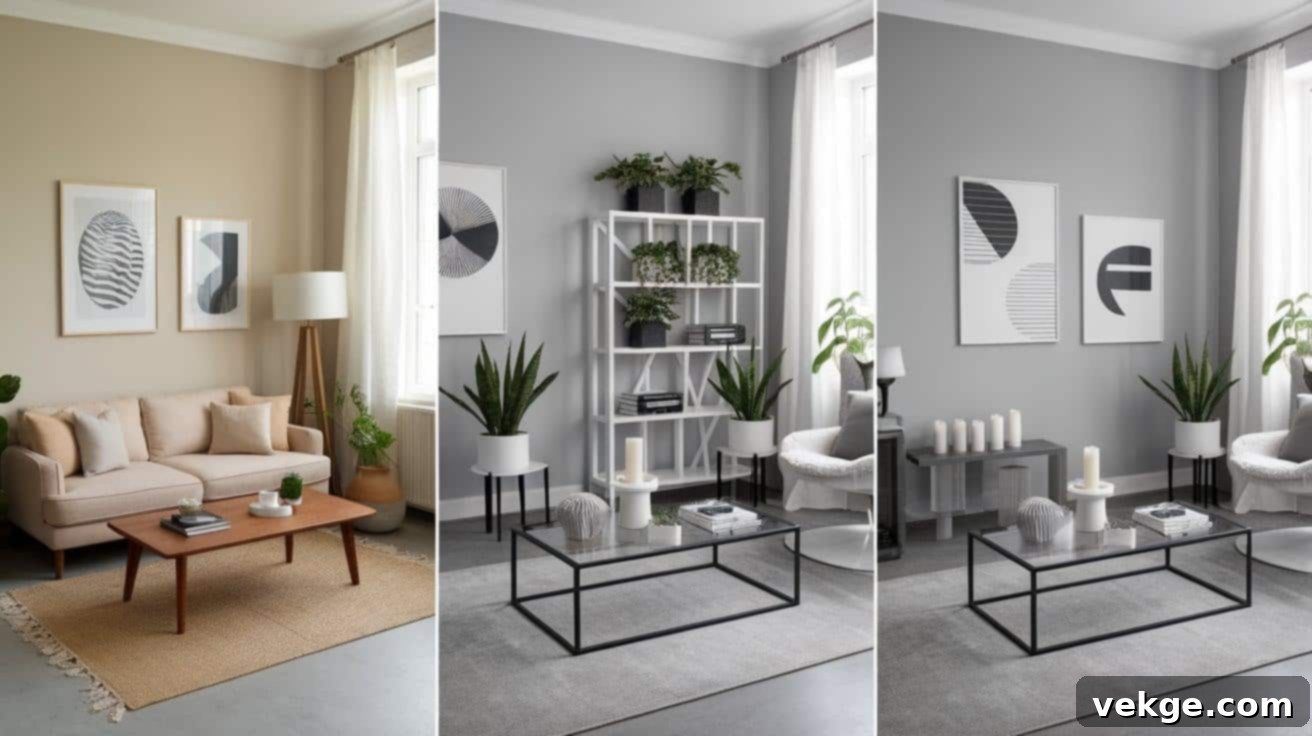
Transforming your home from one distinct style to another can feel daunting, but with a thoughtful approach, it can be an exciting and rewarding process. The key is to proceed strategically, identifying what can be repurposed and what needs to be replaced, all while keeping your budget and desired aesthetic in mind.
1. Assessing Your Current Décor with Fresh Eyes
Begin your transition by thoroughly evaluating your existing pieces. Walk through your home with a critical yet objective eye. Identify quality items like solid wood furniture, genuine vintage finds, or well-made textiles that possess timeless appeal and could potentially integrate into a new style. These are your investment pieces. Conversely, consciously identify and remove items that feel mass-produced, overly trendy, or specifically tied to the more generic aspects of farmhouse style—think overly distressed signs, generic shiplap wallpaper, or clichéd rustic accents. Before making any significant purchases or changes, create a detailed plan. Develop a mood board for your desired new style, gathering images, color swatches, and material samples. Consider which of your existing elements genuinely support your new vision and which require replacement. This thoughtful, planned approach helps prevent costly mistakes, ensures a cohesive result, and allows you to prioritize your efforts effectively.
2. A Step-by-Step Guide to Updating Your Home
Embark on your home transformation in a phased and manageable manner to avoid feeling overwhelmed.
- Phase 1: Wall Colors as Your Foundation. Begin by updating wall colors, as they provide the most significant foundational impact. Choose colors that truly reflect your selected design direction while complementing any existing pieces you plan to keep. A fresh coat of paint offers a dramatic transformation for a relatively low cost and can immediately shift the mood of a room.
- Phase 2: Focus on Key Furniture Pieces. Once your backdrop is set, turn your attention to core furniture items. Replace dated pieces with new ones that better suit your chosen style. Consider starting with one room, such as the living room or master bedroom, to manage both your budget and effort effectively. Look for pieces that offer cleaner lines, more natural textures, or a unique silhouette that speaks to your new aesthetic.
- Phase 3: Update Lighting and Textiles. Lighting fixtures are often overlooked but can profoundly impact a room’s atmosphere. Swap out generic or dated fixtures for options that align with your new style. Similarly, update textiles—curtains, throw pillows, rugs, and bedding. These elements introduce color, pattern, and texture, instantly refreshing the space and contributing to the desired aesthetic.
- Phase 4: Curate Accessories and Art. Finally, carefully select accessories and artwork. Remove all previous farmhouse-specific décor. Instead, introduce items that reflect your personality and complement your new design scheme. Choose pieces that have meaning, add visual interest, and tie the whole look together, rather than simply filling space.
3. Budget-Friendly Tips for a Stylish Transition
You don’t need an unlimited budget to achieve a stunning home transformation.
- Transform Existing Pieces: Give your existing furniture a new lease on life through creative updates. New hardware, a fresh coat of paint, or reupholstering can completely refresh dated furniture without a major expense. Simple changes like updated lighting fixtures (even just new lampshades or bulbs) can dramatically shift a room’s entire feel.
- Shop Smart for Unique Finds: Embrace the thrill of the hunt! Visit estate sales, consignment shops, thrift stores, and online marketplaces for unique pieces with character and history. These sources often offer high-quality items at incredibly reasonable prices. Plus, incorporating pre-owned items is a fantastic way to support sustainability goals and infuse your home with one-of-a-kind personality that mass-produced items simply can’t offer.
- DIY Where Possible: Learn basic DIY skills. Painting, wallpapering, or even simple carpentry projects can save money and give you a sense of accomplishment. There are countless online tutorials for almost any home project you can imagine.
Incorporating Sustainable and Eco-Friendly Design in Your Home
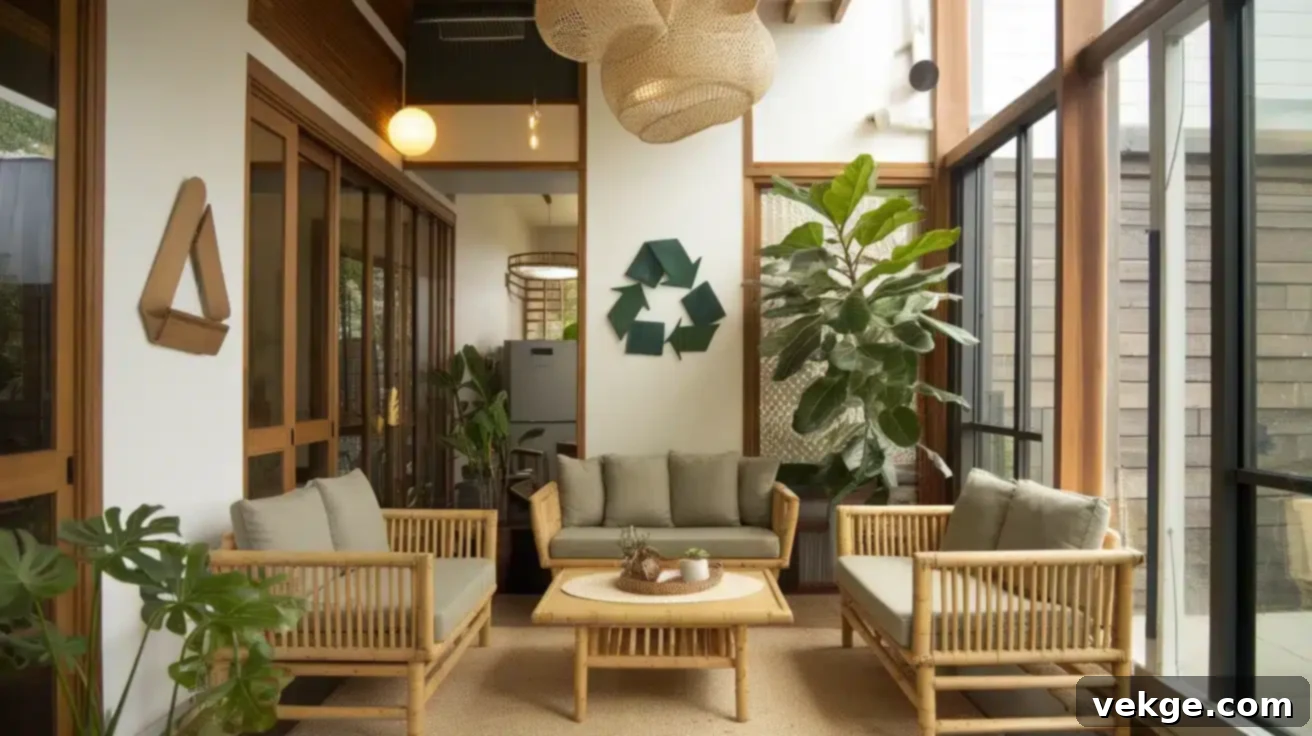
Beyond aesthetics, modern design is increasingly intertwined with ethical and environmental considerations. Incorporating sustainable and eco-friendly practices into your home design not only benefits the planet but also contributes to a healthier, more mindful living environment for you and your family.
Choosing Sustainable Materials for Longevity and Impact
When selecting new items for your home, make it a priority to look for materials certified by recognized environmental organizations, such as FSC (Forest Stewardship Council) for wood, GOTS (Global Organic Textile Standard) for textiles, or Cradle to Cradle certification for overall product sustainability. These certifications ensure products meet specific environmental and social standards, helping to guide your choices. Beyond certifications, consider the longevity and durability of materials. While quality items might have a higher initial cost, they often prove more economical over time due to their extended lifespan. This approach also significantly reduces waste by lessening the need for frequent replacements compared to cheaper, less durable alternatives.
Energy-Efficient Upgrades for a Smarter Home
Integrating energy-efficient solutions into your design is a smart move for both your wallet and the environment.
- LED Lighting Systems: Modern LED lighting systems offer unparalleled style, versatility, and efficiency. Today’s fixtures provide both form and function, with options available for virtually any design style. From tunable white light to smart controls, LEDs can drastically reduce energy consumption while enhancing ambiance.
- Smart Home Features: Beyond lighting, smart home features can further enhance convenience and energy savings. Smart thermostats, automated blinds, and energy monitoring systems allow you to control and optimize your home’s energy use from anywhere, creating a more responsive and efficient living space.
- Window Treatments: In modern design, window treatments serve dual purposes. They are crucial for controlling natural light and regulating indoor temperature, thus improving energy efficiency, while also adding significant style and texture to spaces. Select options that complement your new design direction—such as natural fiber drapes, insulated blinds, or smart shades—while effectively improving your home’s thermal performance.
Supporting Ethical Brands and Local Artisans
Making conscious purchasing decisions extends beyond the materials themselves to the brands and people behind them. Research companies before making purchases; many brands now transparently share their sustainability practices, ethical labor policies, and manufacturing processes on their websites. This transparency empowers consumers to make informed choices that align with their values. Furthermore, actively supporting local artisans and small businesses often means investing in unique, handmade, and sustainably crafted items. This not only helps build community and supports local economies but also ensures quality and originality in your home décor. Their work often adds a distinct character and narrative that mass-produced items simply cannot match, making your home truly one-of-a-kind.
The transition from farmhouse style offers a profound opportunity to create more personal, sustainable, and aesthetically refined spaces. By thoughtfully selecting new elements that resonate with your vision while honoring quality existing pieces, homes can gracefully evolve to reflect current trends, timeless styles, and a deeper commitment to mindful living.
Conclusion: Crafting Your Ideal Modern Home
As home design confidently moves beyond the pervasive farmhouse era, the possibilities for creating your ideal living space have expanded dramatically. The exciting shift is towards homes that are not only stylish and comfortable but also deeply personal, reflecting individual tastes and a commitment to quality and sustainability. The key to navigating this evolution lies in thoughtfully selecting elements that truly speak to your preferences, all while building a comfortable, functional, and livable environment that fosters well-being.
Whether you find yourself drawn to the clean simplicity and serenity of Japandi, the bold and expressive nature of Maximalism, or the refined elegance of Organic Modern, the underlying principle should remain consistent: focus on quality materials, impeccable craftsmanship, and thoughtful design choices. Remember that truly good design isn’t about rigidly following every trend to perfection—it’s about creating spaces where you genuinely feel at home, where every item tells a story, and every corner brings you joy.
Embrace the journey of exploring these new styles, bravely incorporate what resonates most deeply with you, and meticulously craft spaces that will continue to inspire and bring happiness for many years to come. Your home is a canvas; make it a masterpiece that is uniquely yours.
